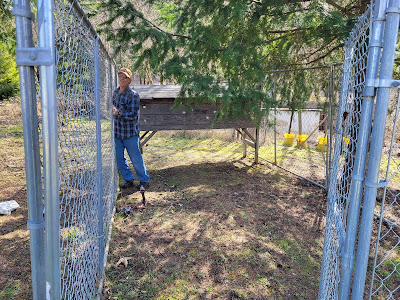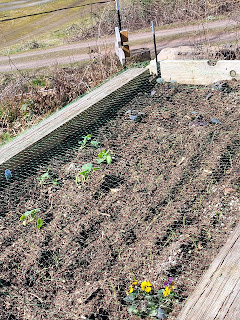It's that time of year again, the time of year I live for all winter long. We're getting some really nice days out. Bob's whittling down his honey-do list. We are just waiting on the last few things we'll need to start brooding our chicks to get delivered and we'll get the coop set up and then we'll go figure out the 15-16 chicks we want to get. I'm just going to say this. Chicks are expensive!
Bob's out there building the chicken run as I type.
We had a friend come up to help Bob move the coop into place. I was really thankful for that.
We bought this coop off of Facebook Marketplace last year. We paid $100 for it. It's a big coop. There's 18 nesting boxes. Realistically, you can have 4-5 laying hens per nesting box. I'm not going to have anywhere near that number of chickens, however. My chickens aren't going to be crowded.
I haven't decided what breeds I want to get, I just know that life is too short for boring white eggs, so I prefer them to have colors.
Bob had to use the panels that we had up for my tomatoes last year. No matter, he's just swapping them out and adding 1 more onto there. I'll still have my tomato garden and it's going to be expanded so that I can fit 60 indeterminate tomatoes onto the trellises.
Bob's going to take this chicken run back to the hog pen. The coop is in the middle of the area. We need to trim those fir branches and the run will be topped with a heavy duty tarp and bird netting. Not only do we have ground predators to contend with (coyotes, bobcat, raccoons and, quite possibly, a cougar), we also have air predators (bald eagles, hawks, owls).
We want our chickens to be as safe as possible.
Bob said he will run some more wire along the bottom of the pen. It will discourage things from trying to dig. A coyote probably wouldn't be able to dig under because we're located on the rim of an old rock pit, but something smaller could do it, possibly.
We have learned that the coop is almost 10-feet wide.
I may have him spin it so that a person can walk past it. I haven't decided yet and it's something that I'll need to discuss with Bob.
So, within the next two weeks, we plan on having our chicks brooding in the coop.
Buying supplies for these chicks was not cheap, either. I still need to get a bag of playground sand, a small pool or container to put the sand in (chickens need to be able to take dust baths), and I suspect we'll be getting another watering set-up for out in the yard once they come out of the brooder. We've dropped $300 so far getting this set up. Chicks are going to run me $4-$7 each.
Here's what our pig pasture looks like. We've already decided that we just can't do it. We cannot raise a meat pig. We'd get WAY too attached to it. That pasture will be better used for something like dairy goats and a mule instead.
Here's the front pen. I would like to use this for turkeys. I would not have one single problem raising turkeys for meat.
About a week ago, I got my tomatoes, peppers and eggplants all seeded out.
I have some pretty obscure varieties this year, like Stoney's Neighbor's. If you couldn't tell, there are times when I will buy a variety for the name alone. I also planted out a variety called Fuzzy Blue Balls. What can I say? I find it hilarious!
The tomatoes have been popping up like crazy lately. Bob was out there this morning and he said there's been like 30 or so pop up.
I can't wait to meet them all.
The garden is starting to wake up. Here is my old rhubarb plant.
I planted out 1/2 pound of Red Musik garlic last October. It's been thriving over the winter.
My eyesight must be going. I already posted the pasture photo.
I'm hoping to get a bumper crop of garlic scapes from these.
I planted out an entire bed of Walla Walla sweet onions.
My big bed is planted out with Red Express cabbage, Tonus broccoli, Primaru onions, Falstaff brussels sprouts and a Tiger Laeta viola plant.
The netting is over the top because we have a feral kitten. She's a cute little thing. Bob's been working with her to gain her trust. We plan on adopting her. He's been able to pet her a few times. Anyhow, I already know that cats look at raised beds like huge fun sandboxes and I'm not into it.
Close up of my garlic. It's super easy to grow. It just takes a while.
Bob's got the frames up for the greenhouses. I think I'll be able to raise some peppers, okra, melons, etc. in there. At least, I hope I can!
I never get tired of looking down that tunnel. It's fantastic!
Rose likes to come out and help.
The raised beds are all tucked in with dead leaves. We'll take some of these off and toss them into the compost pile and we top it with some fresh soil and compost. We figured out what went wrong last year as far as bogus soil. The company wouldn't listen to me and they sold me the wrong type. We went and bought a yard of the right stuff.
I love looking at that greenhouse tunnel from every angle imaginable.
Here's what it looks like from down by the far side of the chicken pen.
This is such an awesome view! I can't wait to get the covers on them. I'm not going to rush it, though, because I don't want to lose it if we get some heavy wind gusts.
Rose is the world's best helper.
I've obtained a few of these barrels. Unfortunately, they have a hole cut into the top. I think we'll cut them in half and use them for raised beds.
My tomato garden looks weird in this photo. It's all put back up now, though, with an extra panel added on.
It will soon be time to get these out and start riding again! I can't wait!
I have a cubic yard of soil in the bed of my truck waiting to fill grow bags and ready to go out onto the beds. We'll probably need 1-2 more before it's all said and done.
So this is what we've been up to here on Kelpie Kapers Farm. How about you? What are you looking forward to the most about spring?


















































